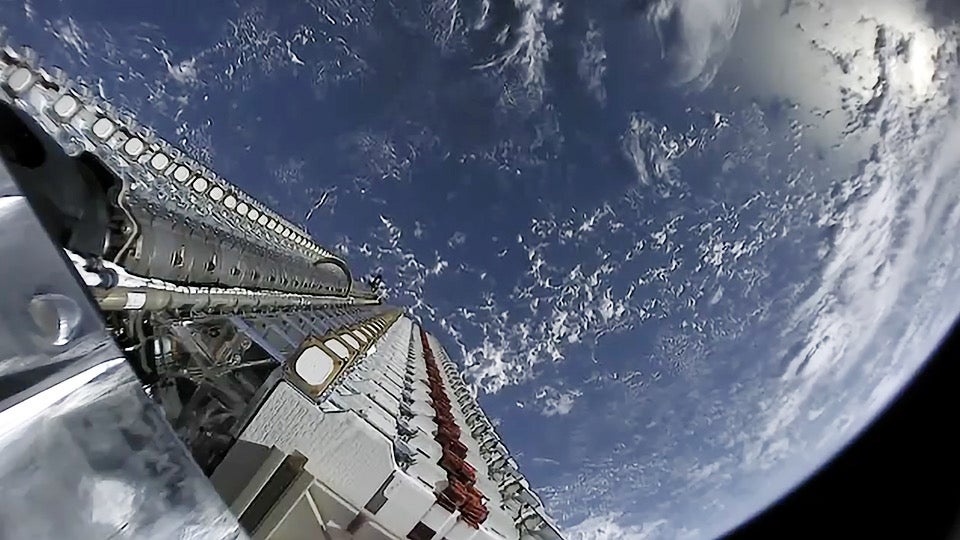
On the whole, it’s been a reliable rule: satellite services such as Elon Musk’s new Starlink aren’t very good for carrying broadband internet traffic.
The first reason for this is that a satellite in low orbit only has line of sight to a relatively small part of the Earth’s surface. This means that the lower the orbit, the more satellites you need to cover the entire planet, or large parts of it. But satellites are expensive things, so the existing low orbit, two-way communications constellations are still high enough to keep the numbers reasonable: examples include Iridium, with 66 spacecraft in operation, Globalstar with 24 and ORBCOMM with 31.
These satellites are still low enough that reasonably compact user equipment with simple antennas can connect with them. The trouble is that they are still quite high up, and as a result their links to simple user terminals on the ground can offer only sharply limited bandwidth. Iridium and Globalstar can carry voice or narrowband data only, not broadband. ORBCOMM users are usually restricted to sending short data bursts every few minutes and ORBCOMM is mainly used for machine-to-machine (M2M) applications.
As a business, low orbit satcomms isn’t the goldmine that some of its advocates suggested it would be back in the 1990s. The unforeseen popularity and ease of international roaming using ordinary mobile phones robbed it of many customers. Iridium, ORBCOMM and Globalstar have all been through bankruptcy and restructuring, and others such as Teledesic, Skybridge, Celestri and Astrolink are gone altogether. ORBCOMM these days prefers to descibe itself as an Internet of Things (IoT) company, and has just been acquired for just over $1bn. Nowadays, with broadband data service more and more important, it’s clear that narrowband platforms like these cannot meet many users’ needs.
Dishing up the data
It’s always been possible to achieve greater bandwidth by the use of a dish antenna pointed at a satellite, rather than a simple omnidirectional antenna. Unfortunately, with an ordinary fixed dish this means that the satellite needs to be sitting still in the sky (and the dish needs to be attached to something that isn’t moving, eg a building). The only way to make this work is to put the satellite much higher up, in geostationary orbit 36,000 km above the Equator, such that it circles the planet in exactly 24 hours. As the planet itself is turning at the same rate, from the surface a geostationary satellite sits dead still in the sky and it is a simple matter to train a rooftop dish on it.
Geostationary works excellently for one-way omnicast applications like television, where a single satellite can cover a large area of the planet below with HD programming. It can also be used to provide broadband internet download to a limited number of dishes on the surface, and such services are on offer. Upload via the satellite is quite possible, but it requires special transmission equipment on the ground. In some cases the upstream connection is actually provided through surface channels – as where a home user receives broadband downloads via rooftop satellite dish, but upload traffic reaches the internet via narrowband landline DSL. Most home users don’t need much upload bandwidth.
How well do you really know your competitors?
Access the most comprehensive Company Profiles on the market, powered by GlobalData. Save hours of research. Gain competitive edge.

Thank you!
Your download email will arrive shortly
Not ready to buy yet? Download a free sample
We are confident about the unique quality of our Company Profiles. However, we want you to make the most beneficial decision for your business, so we offer a free sample that you can download by submitting the below form
By GlobalDataAll this means that geostationary satellite broadband is limited in the number of connections it can provide, it’s expensive, and because the satellites are so far out it suffers from serious latency – enough to ruin online gaming and badly affect video or audio conferencing. It’s mainly used by ships and aircraft (which require complex motorised tracking dishes to remain pointed at the satellite if broadband is required) or by ground users who simply can’t get the bandwidth they need any other way, and who are willing to accept high latency and high prices.
Geostationary satcomms has proven to be less risky as a business than low orbit, but it’s still basically a niche application at the moment. Almost all internet traffic – and other two-way data such as phone calls – moves around the planet not through space, but via undersea cables.
If you live somewhere which is served by only one or two undersea cables (much of Africa and Latin America, for instance) your internet will tend to be expensive and somewhat unreliable. Certain kinds of digital business will also be harder to do: there will not be any major cloud data centres in your part of the world network, for instance. If you live somewhere with no access to the undersea internet backbone at all, geostationary satellite is likely to be the only option and internet access will be one of the problems in your life.
Enter Elon Musk
Some people think that all this should change: most obviously, famous tech tycoon Elon Musk thinks so. He has already launched more than 1,300 of his new ‘Starlink’ satellites, and he has plans to send up thousands more.
With satellites in such numbers, many of the problems disappear. Such swarms of spacecraft can orbit very low and still cover the entire Earth, potentially with many of them in line of sight from any given point on the surface, so permitting large numbers of ground users to connect with them. As the satellites are very close compared to geostationary ones, latency should be comparable to that of the normal surface internet. A directional antenna pointed at the satellite will still be needed to get broadband performance, but there should be no need for complicated motorised dishes to track the fast-moving Starlink spacecraft: a flat ‘pizza box’ sized phased array will be able to generate a beam and aim it electronically without physical movement, rather as some advanced military radars do.
One potential issue is that of backhaul between the satellites and the wider internet. Using ordinary radio techniques would call for vast amounts of spectrum for satellite-to-satellite relay and/or a prohibitively large number of ground stations. But Musk, like others with similar ideas, plans instead to pass traffic around the globe from satellite to satellite using optical links which offer huge potential bandwidth. In space, of course, there are none of the clouds and other atmosphere issues which have kept Earthbound optical links largely inside fibres.
This, really, is the most interesting part of the low-orbit plans: it raises the intriguing prospect of a low-orbit satellite future in which the global backbone consisted of space-to-space optical links, rather than ones carried in undersea fibres. Musk for one has stated that this is the aspiration, and this truly would transform the world’s data networks. That would be genuine disruption.
It should be noted, however, that backbone-fibre-capacity space to ground links would be necessary too, initially to connect the space network to the existing surface backbone and then in the space-based future for such purposes as major data centres and network hubs. There are ways to achieve such very fat space-to-ground pipes, but they aren’t simple and not much work has been done on them yet.
But, at least in theory, Starlink and similar planned operations such as Amazon’s Project Kuiper and London-based OneWeb will be quite different to their ill-fated low orbit predecessors. Musk, indeed, suggests that Starlink might in coming years bring in revenues of $30bn for his company SpaceX. SpaceX has revolutionised the business of space launch with its reusable rockets, but Musk has said that in his view revenues from this business will stabilise at no more than $3bn. If his ambitious dreams of building still more amazing rockets and colonising Mars are to come to fruition, SpaceX will need a great deal more money from somewhere: hence Starlink.
Musk and SpaceX already have one big advantage over other satellite builders, in that they have uniquely affordable launch rockets available at cost. But there are other technical problems to be solved. The thousands of Starlink satellites must be cheaply mass produced, a new thing in the spacecraft business. At the same time, new technologies like the electronically-directed beam antennas and super-economical Krypton manoeuvre thrusters for the satellites must be perfected.
Then, perhaps trickiest of all, SpaceX will need to sell satellite broadband outside its traditional market of people who have no alternative. Much of the human race remains unconnected today, but the cables are spreading around the world faster and faster, and as 5G mobile rolls out it will become easier and easier to hook people up to them. There are probably no more than 750 million people worldwide who can’t be reached by surface networking in the near term, and many of those don’t have much money and thus are not ideal customers.
Plenty of previous analysis has flagged up these problems.
Is Starlink actually a good business idea, or just the only way Elon can get to Mars?
It has to be very possible that 5G hooked to the world’s ever-extending fibre backbone will sink Starlink and its rivals just as 2G and the same fibres sank Iridium and Globalstar. On the other hand it’s quite possible that ordinary urban residents around the world will choose to get an affordable Starlink box and shake off the tyranny of terrestrial telcos and ISPs, but this is yet to be seen.
As for Elon Musk, he makes no secret of his view that the purpose of SpaceX is to achieve human colonisation of Mars – a project to which he has dedicated much of his life. For that to happen, there has to be a way of making huge sums of money in space.
It seems at least possible that Musk believes in Starlink’s potential $30bn revenues mainly because they seem to offer a way ahead to Mars, rather than for objective business reasons.
It would always be unwise to disregard Elon Musk’s view on what can be done in the space business (though he may yet turn out to be wrong on electric cars). But it would probably be fair to say that the business case for Starlink is not as clear-cut as he suggests it is.







